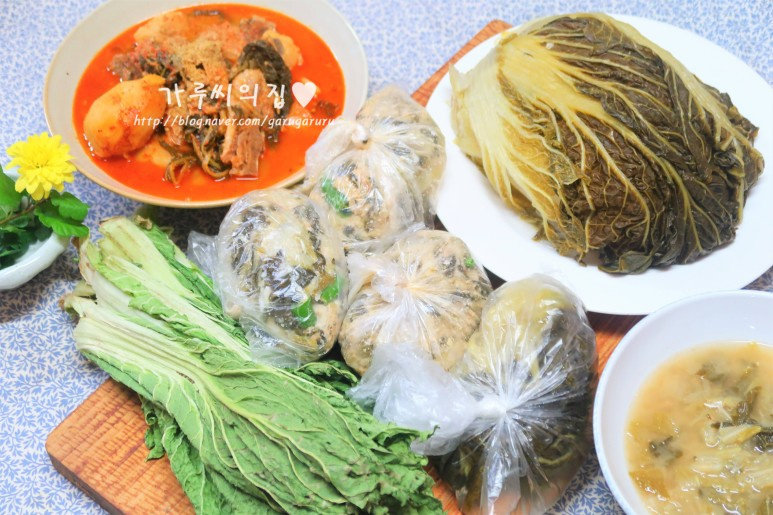Hearty Ugeoji Doenjang Guk (Dried Napa Cabbage Soybean Paste Stew): A Savory Delight!
How to Dry & Boil Napa Cabbage Outer Leaves for Ugeoji, Storage Tips, and Delicious Doenjang Guk Recipe

Don’t discard those outer cabbage leaves! Learn how to transform them into flavorful dried napa cabbage (ugeoji) and use them in a comforting soybean paste stew. This guide covers everything from preparing and boiling the leaves to storing them and making a rich, delicious doenjang guk. Enjoy the satisfaction of reducing food waste and creating wonderful meals!
Main Ingredients- Outer leaves of Napa Cabbage (as much as you like)
Cooking Instructions
Step 1
First, place the prepared outer cabbage leaves generously into a pot. Pour in enough rice water to fully submerge the leaves. Using rice water helps reduce any bitterness and adds a subtle, savory flavor to the cabbage.

Step 2
Cover the pot and bring it to a rolling boil over high heat. Once boiling, reduce the heat to medium and let it simmer gently for about 50 minutes, until the leaves are very tender. This slow simmering process breaks down the tough fibers, ensuring the ugeoji becomes soft and imparts a deep flavor to the stew.

Step 3
Once tender, carefully remove the boiled ugeoji from the pot and rinse it thoroughly under cold running water. After rinsing away any impurities, soak the cabbage in clean water for about 2-3 hours. This soaking step is crucial for removing any lingering raw or bitter taste, ensuring a clean flavor.

Step 4
After soaking and draining, tear the ugeoji into manageable pieces by hand. Don’t tear them too finely, as you want some texture. Portion the torn ugeoji into airtight containers or freezer bags, add a little water, and freeze. This storage method allows you to enjoy fresh-tasting ugeoji whenever you need it.

Step 5
Frozen ugeoji is fantastic when added to dishes like Gamjatang (pork bone soup) or Dwaeji Gukbap (pork and rice soup). It significantly enhances the depth and richness of the broth, adding a wonderfully tender texture to the dish.

Step 6
However, my absolute favorite way to use ugeoji is in Doenjang Guk (soybean paste stew)! Thaw the frozen ugeoji by placing it in cold water. Once thawed, finely chop the ugeoji into bite-sized pieces. Aim for pieces that aren’t too thin, so they retain a pleasant chewiness.

Step 7
In a bowl, combine the chopped ugeoji with 170g of soybean paste, 80g of wet rice flour, 40g of perilla seed powder, 6 Tbsp of minced garlic, 1.5 minced onions (about 300g), and 2-3 finely chopped Cheongyang peppers. Gently mix everything together to thoroughly coat the ugeoji. The rice flour thickens the stew and adds a creamy, nutty flavor, while the Cheongyang peppers provide a welcome hint of spice to balance the richness.

Step 8
Portion the seasoned ugeoji into freezer bags or containers and store it in the freezer. When you’re craving a comforting bowl of doenjang guk, simply take out a portion. First, make a broth using dried anchovies and kelp. Once the broth is ready, add the seasoned ugeoji and bring it to a boil. In no time, you’ll have a wonderfully savory and deeply flavorful Ugeoji Doenjang Guk, perfect for enjoying with a bowl of rice!

Step 9
Another excellent method is to dry the outer cabbage leaves. Wash and thoroughly dry the leaves, then hang them in a cool, well-ventilated area away from direct sunlight for several days until they become dried ugeoji. Dried ugeoji offers a distinct, robust flavor and texture that’s truly special.




